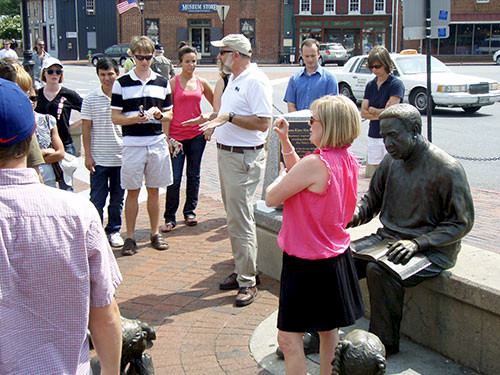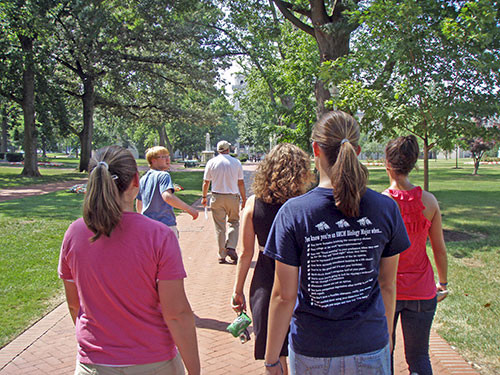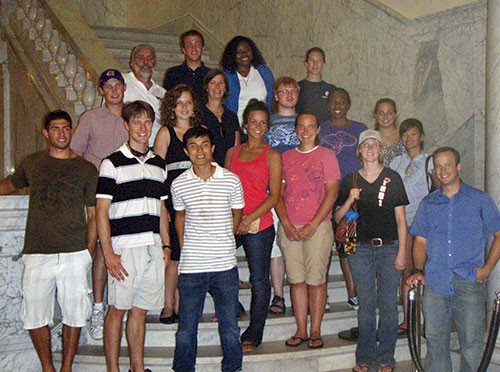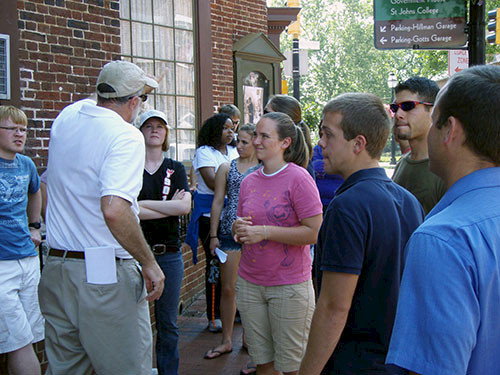Annapolis walking tour
Bill Dennison ·Following a science communication training session with the Research Experience for Undergraduate program at the Chesapeake Bay Program, we took a brief walking tour of historic downtown Annapolis. We stopped at the Alex Haley monument, U.S. Naval Academy, Maryland State House, Thurgood Marshall statue, and pointed out the Banneker-Douglass Museum.
We crossed the bridge from Eastport into Annapolis and our first stop was the Alex Haley monument. The harbor side of historic Annapolis has a statue to Alex Haley, the author of "Roots", his story of tracking his genealogy to his African slave forefather, Kunta Kinte, who arrived in Annapolis in 1767. Alex Haley also was co-author of "Autobiography of Malcolm X". There are three children listening to Alex Haley read his book in the memorial.

We pointed out that during the storm surge associated with Hurricane Isabel in 2003, the statue of Alex Haley was almost submerged and the streets behind the statue were underwater also. An ice cream shop along the inner harbor has a photograph taken during the 2003 storm surge. The narrow harbor is known as "Ego Alley", referring to the people who drive their boats into the harbor to be seen.
The next stop was the United States Naval Academy, which occupies the waterfront at the junction of the Severn River and Spa Creek. It is a beautiful campus for the 4,400 students that attend. Following graduation, they enter the Marines as second lieutenants or the Navy as ensigns. The year 1 students are known as plebes and the years 2-4 students are midshipmen; and we saw a few walking around, even though the semester was over. Students are nominated by congressmen, senators, the Vice President and the President, thus they are from every American state. Some famous alumni include President Jimmy Carter, Senators John McCain and James Webb, Jr., some 50 astronauts including Alan Shepard (first US astronaut in space), Jim Lovell (Apollo 13) and Charles Bolden (current NASA administrator), some 45 Rhoades scholars, David Robinson (NBA), Roger Staubach (NFL), Chester Nimitz (WWII Pacific fleet commander), Hyman Rickover (nuclear submarines), oceanographer Matthew Fountaine Maury, SiFi author Robert Heinlein, businessman Ross Perot, Congressman Charlie Wilson (Charlie Wilson's War), and Michael Mullin, current Chair, Joint Chiefs of Staff.

We stopped in front of Bancroft Hall, named after the Secretary of the Navy George Bancroft, who established the Naval Academy in 1845. It houses the entire student body and is the largest dormitory in the world. In front of Bancroft Hall there is a replica of the Japanese Bell that Commodore Matthew Perry brought back from Japan in 1855. We stood next to the Tecumseh statue, a bronze replica of the figurehead on the USS Delaware, stands near the entrance to Bancroft Hall. The students often paint and decorate Tecumseh, particularly when the annual Army-Navy football game is played. Walking along a bit further, in the grassy mall in front of Bancroft Hall an obelisk called the Herndon Monument stands about 20' high. A graduation ritual is that the midshipmen place a hat on the peak of this monument and the plebes form a human pyramid to swap out one of their plebe hats to signify their higher status. The midshipmen don't make this easy by greasing the obelisk and attaching the hat to the obelisk with epoxy.
We stood in front of the chapel with its large impressive green dome. Underneath the chapel is the crypt containing John Paul Jones, the Scottish born ship captain who Thomas Jefferson described as "The principal hope of America's future efforts on the ocean". Jones was famous for uttering the line "I have not yet begun to fight" while commander of the Bonhumme Richard, engaged in battle with the British ship Serapis on the North Sea in 1779, a battle that he won. Following the Revolutionary War, Jones captained ships for the Russian Navy and retired to Paris, where he died in 1792. Over one hundred years later, an American Ambassador and an anthropologist located his body (in a lead coffin pickled in alcohol) and it was shipped to the US Naval Academy in 1905. President Teddy Roosevelt presided over a ceremony when the body arrived. It is now directly under the chapel, guarded by Naval Academy students.
We walked out the Naval Academy gate near the entrance to the crypt, where there is a movie trivia site. In the film "Patriot Games", based on a Tom Clancy novel, the hero played by Harrison Ford is leaving the Naval Academy when some Irish Republican Army terrorists attempt to assassinate him.
On our way to the Maryland State House, couple blocks away from this Naval Academy entrance is the entrance to St. John's College, a small liberal arts college founded in 1696 as a preparatory school and it became a college in 1784. Often you can see students playing croquet on the front lawn of St. John's College. They have an annual croquet match with the Naval Academy and generally beat them, including a 5-0 win in 2010.
We next went to the Maryland State House, the oldest state capitol in continuous use. It was completed in 1779. It even served as the nation's capitol for a brief but historically significant period. The Continental Congress met in the Old Senate Chamber from November 26, 1783 to August 13, 1784. During that time, two major events occurred. One was the ratification of the Treaty of Paris, negotiated in Paris by Ben Franklin, John Adams and John Jay, ending the Revolutionary War with Great Britain. The other significant event was when George Washington appeared before the Continental Congress to resign his commission as commander-in-chief of the Continental Army. Washington was in New York City on December 4, 1783 to watch the last ship with British soldiers sail back to Great Britain, and then rode to Annapolis to resign his commission, arriving on December 19. On December 23, 1783, he stood in the Old Senate Chamber (a plaque in the floor marks this spot) and said "Happy in the confirmation of our independence and sovereignty, and pleased with the opportunity afforded the United States of becoming a respectable nation, I resign with satisfaction the appointment I accepted with diffidence." He concluded his remarks with "Having now finished the work assigned me, I retire from the great theatre of Action; and bidding a Affectionate farewell to this August body under whose orders I have so long acted, I here offer my Commission, and my leave of all the employments of public life." Washington left the next morning for Mount Vernon, arriving late Christmas Eve to return to civilian life, like the Roman general Cincinnatus. King George III of England heard about Washington returning to civilian life and allegedly said "If he does that, he will be the greatest man in the world."

From inside the capitol building, we looked up into the very tall wooden dome, made from timber from Somerset County on the Eastern Shore. The dome has no metal nails, rather is held together by wooden pegs reinforced with iron straps. From the outside we viewed the dome's lightning rod on top of the wooden dome. The cast iron rod is known as a "Franklin" rod, constructed to specifications by Benjamin Franklin. The use of this rod was a political statement when the building was constructed, based on Franklin's theories of lightning, diametrically opposed theories supported by King George III.
We went to Lawyer's Mall in front of the entrance to the Maryland State House. Lawyer's Mall has a statue to Thurgood Marshall, (1908-1993), a Maryland icon who served on the U.S. Supreme Court from 1967-1991. Also depicted as statues on benches facing Thurgood Marshall are two African American children with school books and a young man. The children and young man represent Thurgood Marshall's landmark case Brown v. Board of Education of Topeka, when as chief counsel to the National Association for the Advancement of Colored People, he successfully argued against school segregation. The young man is Donald Murray, the first African American admitted to the Law School of the University of Maryland.

We finished the tour off with a stroll down Main Street, stopping off for ice cream. The REU students were troupers, as the temperature was in the 90s and the sun was blazing down, but we didn't lose anybody, even after the signers who were assisting the two hearing impaired students faded.

About the author
Bill Dennison

Dr. Bill Dennison is a Professor of Marine Science and Vice President for Science Application at the University of Maryland Center for Environmental Science.

